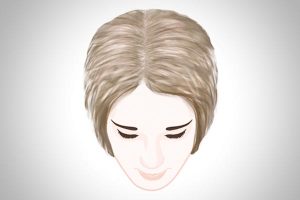Not all hair loss is the same. In some cases it is hereditary, while in other cases e.g. stress, an unbalanced diet or diseases are the trigger. All they have in common is the result: thinning hair. The most commonly occurring forms are “diffuse hair loss” and hereditary hair loss. Another form is circular hair loss (alopecia areata), which produces clearly delimited bald patches. The causes of circular hair loss are not yet fully understood, but it is assumed to be an autoimmune disease. In each case, the treatment should be administered by an experienced dermatologist.
Contrary to popular belief, hair loss is not a purely male problem: around 40% of all women suffer from a form of hair loss at least once in the course of their life requiring treatment.
DIFFUSE HAIR LOSS
 If the entire head is affected by hair loss and the number of hairs lost exceeds the normal amount of 100 hairs per day, this is diffuse hair loss. Although the hair bulb is intact, it is not sufficiently supplied with nutrients like amino acids (e.g. cystine) and B-group vitamins through the bloodstream.
If the entire head is affected by hair loss and the number of hairs lost exceeds the normal amount of 100 hairs per day, this is diffuse hair loss. Although the hair bulb is intact, it is not sufficiently supplied with nutrients like amino acids (e.g. cystine) and B-group vitamins through the bloodstream.
This has consequences:
- The hair bulb ceases its activity at some point.
- The life of the hair is shortened.
- It falls out prematurely.
- Increased hair loss is the result.
The reasons for diffuse hair loss are many and varied. In women, it is mainly caused by certain life circumstances:
- Stress
- Nutritional deficits/diet
- After pregnancy
- Severe infections, e.g. flu
- Certain metabolic disorders
- Special form of seasonal hair loss (hair loss in spring or autumn)
Treatment
The cause of diffuse hair loss should be identified and, if possible, eliminated during a visit to the doctor. Hair loss can also be successfully treated by supplying suitable nutrients, e.g. Pantogar®. Because of the hair’s life cycle, the treatment should be carried out for at least 3 to 6 months.
Recommendation: 3 x 1 capsule per day
ALOPECIA AREATA
 This form of hair loss is also called circular hair loss, or spot baldness. It is characterised by distinct, sharply defined bald patches of different sizes.
This form of hair loss is also called circular hair loss, or spot baldness. It is characterised by distinct, sharply defined bald patches of different sizes.
Alopecia areata is an inflammatory, usually reversible form of hair loss. The cause is unknown. Most likely, immunological (concerning the body’s defence mechanism) processes play a role in the development of the disease. Hereditary factors also seem to be of relevance, as in about 25% of cases the disease occurs in families.
Alopecia areata should be treated by a doctor.
HEREDITARY HAIR LOSS IN WOMEN
When women’s hair thins, especially in the crown area, this is usually a matter of genetic predisposition. A tendency towards hair loss is passed down from parents to their children. In these cases, the hair bulb reacts very sensitively to the body’s own hormones that control hair growth. Hair becomes shorter and thinner. Finally, only very fine and short hair grows.
Hereditary hair loss is the most common form of hair loss in men, accounting for 95 percent of all cases. But what many people do not know is that women can also suffer from this androgenic alopecia.
In addition to the basic cause of hereditary predisposition, the following factors can lead to this form of hair loss in women:
- Change of life (menopause)
- Hormonal imbalances

